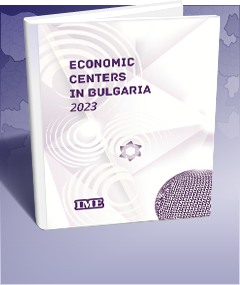Sofia-Pernik-Botevgrad Economic Centre
SOFIA-PERNIK-BOTEVGRAD
ECONOMIC CENTER
- INTRODUCTION | Key indicators for the Sofia–Pernik–Botevgrad economic center
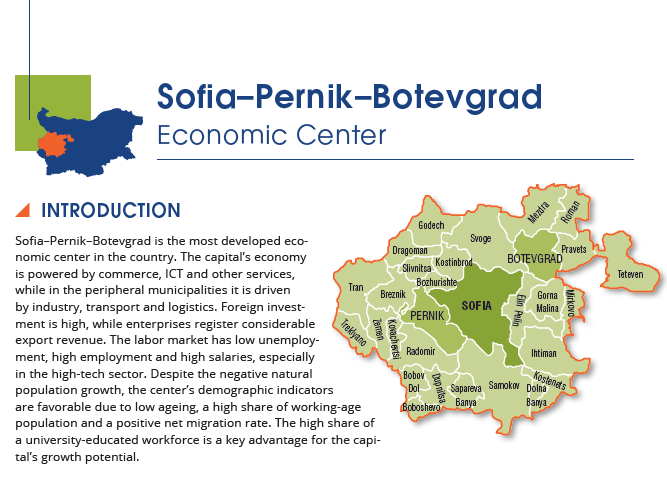
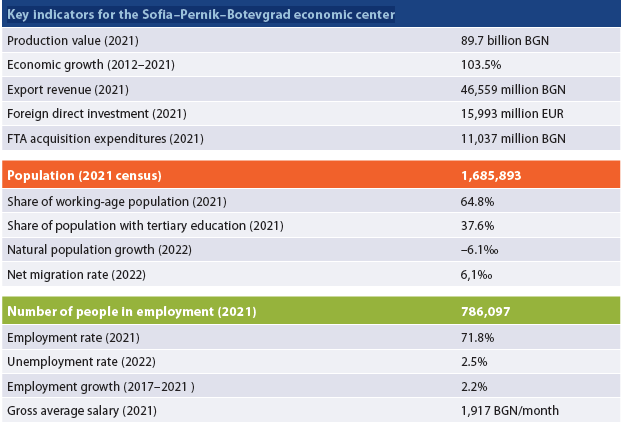
- COMPOSITION AND LABOR MIGRATION
The economic center consists of three cores – the municipalities of Sofia (capital city), Pernik and Botevgrad, the capital city’s periphery comprising 29 municipalities, including the two smaller cores and their peripheries. The daily labor migration from the peripheral municipalities to the capital amounts to 42,200 people, with the greatest number coming from Pernik (13,100 people), Svoge (4,100) and Kostinbrod (3,400). Jobs in the capital city make up the highest share in the employment of Svoge – 49% of all employed persons in the municipality commute to their jobs in Sofia, 47% in Bozhurishte and 40% in Kostinbrod. In comparison with the previous edition of the study (2017), the number of municipalities in the center has increased by 1/3, all municipalities being part of the administrative districts of Sofia – capital city, Sofia, Pernik, Kyustendil, Vratsa and Lovech. In about a dozen other municipalities the share of daily labor migration to the cores also nears 10%, which could potentially turn them into periphery in the near future.
- ECONOMY AND INVESTMENT
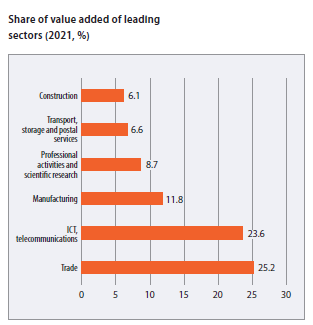 Sofia–Pernik–Botevgrad is the center with the highest production value in the country – 89.7 billion BGN in 2021, or 53,000 BGN per capita and about 50% of the total production of all 16 centers. The growth of value added over the last 10 years is 104%, with only the centers around Plovdiv and Kardzhali developing faster. Despite the large number of municipalities in the center, value added is highly concentrated in the capital (92.5%), with only Pernik (1.6%), the logistics center Elin Pelin (1.3%) and the industrial center Botevgrad (1.1%) having shares of any significance. The leading sector is trade with a share of 25% of the value added, followed by the fast growing ICT sector (24%). Manufacturing, better developed in the peripheral municipalities also plays a significant role with a share of 12%, as well as professional activities (9%) which include the outsourcing of various business service. The center is home to the largest employers in the country – NRIC with 11,000 employees, Bulgarian Post with 8,300 employees, Kaufland Bulgaria with 5,800 employees, and BDZ-PS with 5,300 employees. However, it must be noted that a significant share of the employees officially reported in these enterprises have workplaces distributed across the country.
Sofia–Pernik–Botevgrad is the center with the highest production value in the country – 89.7 billion BGN in 2021, or 53,000 BGN per capita and about 50% of the total production of all 16 centers. The growth of value added over the last 10 years is 104%, with only the centers around Plovdiv and Kardzhali developing faster. Despite the large number of municipalities in the center, value added is highly concentrated in the capital (92.5%), with only Pernik (1.6%), the logistics center Elin Pelin (1.3%) and the industrial center Botevgrad (1.1%) having shares of any significance. The leading sector is trade with a share of 25% of the value added, followed by the fast growing ICT sector (24%). Manufacturing, better developed in the peripheral municipalities also plays a significant role with a share of 12%, as well as professional activities (9%) which include the outsourcing of various business service. The center is home to the largest employers in the country – NRIC with 11,000 employees, Bulgarian Post with 8,300 employees, Kaufland Bulgaria with 5,800 employees, and BDZ-PS with 5,300 employees. However, it must be noted that a significant share of the employees officially reported in these enterprises have workplaces distributed across the country.
The center also ranks first in foreign investment, which by the end of 2021 reached 16 billion EUR cumulatively. Foreign capital is directed almost entirely towards enterprises in Sofia municipality – 14.7 billion EUR, while significant FDI is also attracted by Elin Pelin (430 million EUR), Botevgrad (278 million EUR) and Bozhurishte (263 million EUR). The distribution of foreign investment in the capital is relatively balanced between the different sectors, with trade, transport and tourism leading the way (4.5 billion EUR), while in smaller municipalities it tends to be directed towards industry and logistics. The center has the highest investment activity in the country, with FTA acquisition expenditure in 2021 averaging 6,500 BGN per capita, mostly concentrated in trade, transport and tourism. Export earnings in 2021 were 47 billion BGN, generated by commerce, ICT and manufacturing. The center has the third highest average labor productivity in the country – 23,900 BGN value added per employee per year.
- LABOR MARKET
Sofia–Pernik–Botevgrad has the lowest unemployment rate among all the centers – 2.5% according to the Employment Agency data for 2022. The lowest unemployment rate is in Sofia municipality (1.5%), but in some remote small municipalities the rate remains high – up to 21% in Tran and 14% in Treklyano.
In most municipalities, especially in the capital and those neighboring it, there are almost no long-term unemployed with more than a year of registration in the labor offices, with a more significant share only in the small municipalities near Pernik and especially in Tran, where they are 10.2%. The shares of unemployed young people are relatively high compared to the leaders; in most of the small municipalities of the economic center, between 2% and 3% of the population aged 15–29 are unemployed, while in the capital this share is 0.6%.
The employment rate for the 15–64 age group in the center is 71.8%, though there are large differences between municipalities: while in Sofia municipality the employment rate is 75%, in most small municipalities it varies between 55% and 65%. The total number of employed persons exceeds 786,000, of which 629,000 are in the capital and 35,000 in Pernik. Botevgrad, Elin Pelin, Dupnitsa and Samokov also have over 10,000 employees. The Sofia–Pernik–Botevgrad center is among the few in which the total number of employees has registered some growth in recent years, albeit it is relatively low – 2.2% for the period between 2017 and 2021. The highest share of employees is in trade (23%), ICT (13%) and manufacturing (12%).
Between 2017 and 2021 the average salary in the center increased by 49% to 1,917 BGN per month on average, which is mainly due to the dominant share of the labor market of the capital city, where the average salary is 2,144 BGN per month. The highest salaries in Sofia by 2021 were in ICT (4,101 BGN per month), professional activities (2,743 BGN per month) and healthcare (2,235 BGN per month).
- HUMAN RESOURCES AND WORKFORCE
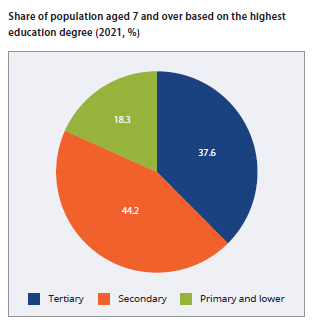 Between the 2011 and 2021 censuses, the municipalities in the Sofia–Pernik–Botevgrad center lost 3.9% of their population; 1.69 million people live in the center – over 1/5 of the total population of Bulgaria. Among all the country’s centers, Sofia–Pernik–Botevgrad has the highest share of working-age population – 64.8%: 838,000 people in the capital, 53,000 in Pernik, 23,000 in Dupnitsa. The share of elderly population is relatively low compared to the national average, with 20.8% of the population aged 65 and above, while demographic replacement indicators show a relatively slower ageing process.
Between the 2011 and 2021 censuses, the municipalities in the Sofia–Pernik–Botevgrad center lost 3.9% of their population; 1.69 million people live in the center – over 1/5 of the total population of Bulgaria. Among all the country’s centers, Sofia–Pernik–Botevgrad has the highest share of working-age population – 64.8%: 838,000 people in the capital, 53,000 in Pernik, 23,000 in Dupnitsa. The share of elderly population is relatively low compared to the national average, with 20.8% of the population aged 65 and above, while demographic replacement indicators show a relatively slower ageing process.
The area around the capital is among the main attraction points for migration, with an average net migration rate of 6.1‰ for the center in 2022. However, the rate is negative in the greater part of the center, as most settlers choose one of the three cores, especially Sofia and Pernik. The natural population growth is relatively favorable (–6.1‰) compared to the national average, but varies considerably between municipalities: from –3.4‰ in the capital to as much as –51‰ in Kovachevtsi.
The Sofia–Pernik–Botevgrad center has the most favorable educational structure in the country, with a share of persons with higher education among the population aged 7 and above of 37.6%, while the share of population with primary or lower education is only 18.3%. In the capital city, the number of university graduates is significantly higher – 43.6%, but in most of the peripheral municipalities this share is in the range of 15–20%, while the leading share there is that of secondary education. The share of illiterate persons is the lowest in the country – 0.5%, with the exception of the municipalities of Tran (4.2% illiterates), Pravets (2.5%) and Ihtiman (2%). Students’ results are among the highest in the country – at the 2022 matriculation exam, the average score in BLL is Good 4.24 and the average score in the NEA in mathematics at the end of grade 7 is 42.6 out of 100. Most of the country’s successful and leading secondary and higher education schools are located in this economic center.
Latest news
Math talents on the edge of the map 30.06.2025
If you think that mathematics can only be taught and learned well in mathematics high schools or elite...
The municipalities need more own resources and a share of revenues from personal income taxation 26.06.2025
IME analysis shows opportunities for expanding municipalities' financial autonomy. The budget expenditures...
